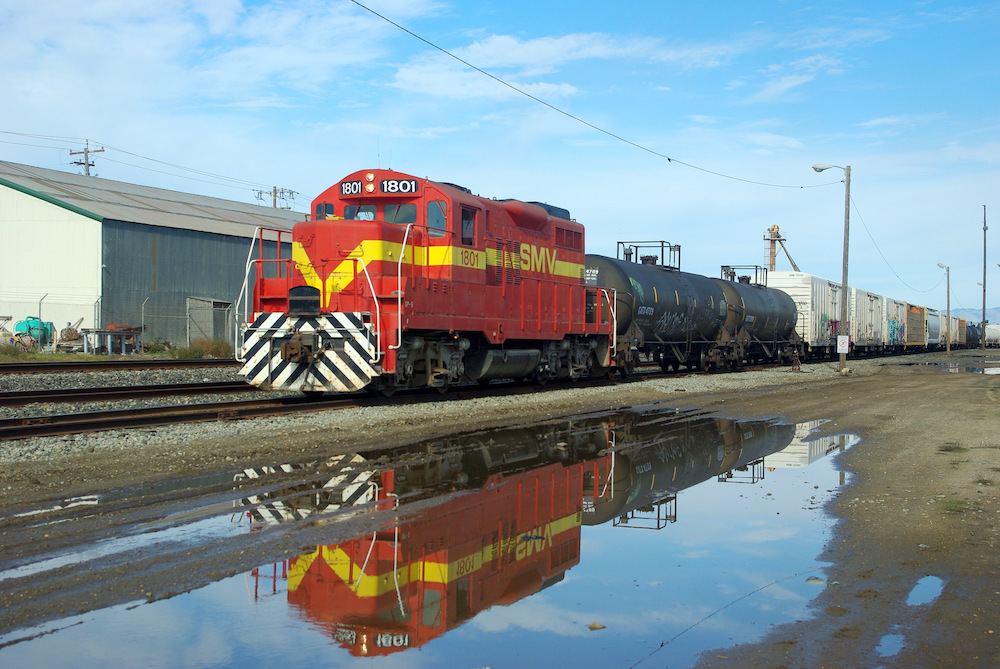
Rob Himoto’s Santa Maria Valley Railroad is the quintessential short line success story. His family bought the struggling 13.72-mile independent short line in 2006. Through hard work, they’ve been able to quadruple annual carloadings, diversify the railroad’s traffic base, and improve its track.
Himoto is understandably proud of the turnaround and the role the railroad plays in taking long-haul freight off the highway in California and beyond. But now the California Air Resources Board has come along with new locomotive emissions regulations that could bankrupt the Santa Maria Valley and threaten the viability of many of the state’s 24 other short lines.
The regulations, approved in April, pack a one-two punch. The first is an excise tax on locomotives that goes into effect in 2024, with the amount based on emissions each locomotive produces. The second prohibits locomotives older than 23 years from operating in California beginning in 2030. CARB’s wacky idea is that the excise tax is a forced savings plan that will help Class I and shortline railroads pay for new clean-burning or zero-emissions locomotives.
But the yearly excise tax will be a knock-out blow for some short lines. In Santa Maria Valley’s case, the bills on its active fleet — a GP7, GP9, and GP35 — will exceed the railroad’s annual revenue. What’s the Santa Maria Valley going to do when the forced savings account plan goes into effect next year? “I don’t know,” Himoto shrugs. “We’re at a loss.”
And there aren’t any other options. Santa Maria Valley rosters a pair of GE 70-tonners that are exempt from the excise tax because they produce less than 1,006 horsepower. Could they take over for the Geeps? “No,” Himoto laughs, shaking his head. “Not with our traffic.” The 70-tonners can’t handle the railroad’s typical 35- to 40-car train.
Even if there were a way to avoid or find the money to pay the excise tax, there’s still the looming 2030 deadline to replace older power. Buying new is for the big boys. Union Pacific has ordered 20 battery electric locomotives to test in yard work, including in West Colton, Calif. The tab: More than $100 million for the locomotives and related yard infrastructure improvements. That works out to $5 million per unit, which is out of the question for a short line.
What about state or federal grants? “Even if there’s a grant for it, there was a grant in California that covers 75%,” Himoto says. “But what’s 25% of $5 million? It’s still too much for us.”
Himoto realizes that nothing lasts forever, and even without the new regulations the railroad eventually will have to replace its aging locomotives. A good used GP38-2, which might cost $200,000, is affordable. It’s another matter entirely when the railroad would have to buy a Tier 4 switcher that costs nearly as much as a new $3 million Tier 4 road locomotive.
“But how do you do it with the revenue we make? Our revenue needs to go to other capital projects. We still need to refurbish a lot of track. You need good track before you run trains,” Himoto says. “My thinking is you’ve got to build up the business and revenue to justify buying new locomotives.”
Short lines don’t argue the need for cleaner air and reduced carbon emissions. But CARB’s heavy-handed approach — all stick and no carrot — is going about it the wrong way. It’s not offering new grants, incentives, workable exceptions, or wiggle room. Just air-tight rules.

So Himoto worries about the future of his railroad, its 10 employees, and its two dozen customers. “This is a total threat. The revenue isn’t there to convert that quickly. And then the technology isn’t really there yet,” Himoto says.
He’s right: Battery electric or hydrogen fuel cell locomotives are still in the prototype stage, something that CARB misunderstands. No shortline wants to be a proving ground. They need locomotives they can count on. “We can’t afford down time,” Himoto says.
It’s unlikely that short lines could pass the cost of compliance on to their customers. So CARB’s rules may put some short lines out of business. This would send freight to the highway, increasing air pollution and congestion while reducing safety. In all, California short lines handle 260,500 carloads per year, or the equivalent of 781,500 truckloads. The railroads have pointed this out to CARB repeatedly. “They don’t even care,” Himoto says. “They’re saying, ‘No, you’re the problem. You’re the polluter.’ ”
The Association of American Railroads and the American Short Line and Regional Railroad Association will challenge the regulations in court. Himoto says some California legislators have been sympathetic. But it’s unclear how they can help.
Meanwhile a frustrated Himoto can’t do much but worry and wait. “We’re holding our breath on this thing,” he says.
You can reach Bill Stephens at bybillstephens@gmail.com and follow him on LinkedIn and Twitter @bybillstephens














Looks to me like Calif people are voting with their feet leaving the state due to overbearing regulations and costs. You can talk about funded debt all you want. Debt will become much higher when many of the population have left which will increase the debt demand of out of control government. It looks like railroads will be the canary in the mine to be followed by——————.
Could California afford the cost of stringing up overhead wire and go back to electric interurbans?
CARB has provided grant money before. Witness Los Angeles Harbor lines.
simply allow any piece of equipment to run for as long as it is compliant to the existing federal and state laws at time of manufacture, allow locomotives to continue to operate with upgraded, newer, cleaner power plants, example, eco20’s, meeting federal and state emissions levels,also at time of conversion. what they are doing is foolish, just like taking a 1963 split window corvette, 237/4spd, making the owner go bankrupt trying to comply with laws 60 years after it was built.
Well eventually the railroad won’t be able to afford to buy expensive new motive power, so the freight will have to go to trucks. But California is banning diesel trucks starting in 2036. There won’t be anymore nuclear plants of coal plants, so there won’t be enough power to go around. Seems like the whole ecomony will just shut down. But maybe that’s what they are going for?
Again, Gov’t getting in the way of private business, thus grabbing it by the throat and smuthering it. Shortlines need to band together and tell the Cali Gov’t to go screw. Without the shortlines, that provide jobs and tax revenue, the stupid state will have less income. They are SO STUPID. Most of these shortlines cannot afford these Govt mandates and laws and will likely fold and the business’s that depend on the shortlines will also fold, because the rail transportation is the cheapest means and helps the bottom line for that business. IDIOTS!!!! Another DUMB idea by Gov’t.. Oh and challenge me on Gov’t is good.. The Post Office, run by gov’t have trucks that suck in winter and get stuck all the time, no head and it is 160 BILLION in Debt.. That is well run!!! That should be shut down too.. Post office sucks also.
About the only thing CARB should stick too is stuff it knows about, which is mostly highway related and industrial pollution…they don’t know Jack about railroads. I live here, and the only thing I think CARB has been good for is getting the auto industry to continually increase gas mileage in their vehicles. Of course, that is nothing to say of what they did to the Tucker, which at the time could get 50 miles to the gallon…imagine how much better shape this country would be in had he been allowed to succeed.
What will fuel California’s transportation in the future? To qoute the line in Cheech and Chongs Christmas, “Its like the magic dust man”
I don’t know if SMV is a Class II or Class III railroad. If it is the latter, it would have been nice if Bill Stephens had done a little digging into this (from the CARB fact sheet on the new rules): “The Small Business Hardship Extension will allow qualifying applicants to be granted a reduced Spending Account payment, a limited extension of eligibility to operate under the In-Use Operational Requirements, or a combination of these relief options.” To say, as Bill did in the piece, “It’s not offering new grants, incentives, exceptions, or wiggle room. Just air-tight rules” – is at odds with the facts, at least for Class IIIs and industrial users.
It’s also perplexing to me that anyone would say “it’s not clear how (legislators) can help.” CARB is not a sovereign entity, as fearsome as its detractors make it out to be. Small operators that are jeopardized by the regs need to understand it’s time for a full-court press on state Senators, Assembly members, and local news organizations that are more likely to get attention from legislators and constituents than Trains News Wire. The best time to lobby is before rules are adopted, but the next best time is now.
Terry, thanks for reading and taking the time to comment. SMV is a Class III. My understanding of the hardship extension is that it merely delays the inevitable and does not let a railroad off the hook. If a railroad can’t afford the payments, and can’t afford new power, the end result is the same: They’ll be regulated out of business. The only question is when. The California and national short line groups, as well as individual short lines, commented multiple times on the flaws in the proposed regulations. CARB did not modify the regulations to take into account their impact on small businesses.
Businesses in general, and railroads in particular, need to figure out how to obviate California. It’s roughly 135 miles from Arizona’s southwestern corner to the Pacific on the Mexican side of the border. How much for a new port and connecting railway?
Welcome to the Communist Republic of California. It used to be a joke that Davis, California, was the Peoples Republic of Davis, a play on the ordinances in Davis that regulated almost your entire life whilst in the city.
You forgot Bizerkeley!
Yes, the fascist lunatic loons running CARB (and California) into the ground are doing all they can to destroy private-sector economy in California, seemingly without any concern or consideration of the consequences of their actions. So if the fascist loons at CARB put the Santa Maria Valley RR out of business with these heavy-handed locomotive conversion requirements (to new technology that either doesn’t exist or is unproven) and all of their business shifts to diesel-burning trucks (less efficient and more polluting), how does that help improve California’s air-quality and overall environment? Obviously it doesn’t …….(but the morons at CARB obviously don’t get it, or don’t care ….).
And yes and ‘amen’ to the remarks above. California is (supposedly?) the ‘trendsetter’ for the nation and the lunacy that originates in California eventually spreads to the rest of the country. “We need to be more like California…” goes the progressive screed.
No, we don’t …….
What state is mired in deficit spending? What state has turned its biggest cities into drug-infested crime-ridden hellholes with human sh…. all over the sidewalks? What state has some of the worst educational outcomes? What state has the biggest income disparity, rich to poor? What state has some of the worst water shortages and some of the worst air pollution? What state has the biggest population loss in recent years? What state is losing buinesses to Texas?
Hint: The capital is Sacramento.
So no, I’m not obliged to say anything good about its environmental policies.
That’s the problem with giving in to tyranny. The corrupt governments only get more powerful and their grip gets tighter.
Just the beginning. Wait until Donner Pass is impassable because no electric plow can handle it. Wait until the port of Long Beach goes back into a meltdown because there isn’t enough motive power that meets the new regs.
Regulating ones backyard grill isn’t too far behind I am afraid.
Watch for the newsline, “In and Out Burger will be shutting down because their chimneys could not remove the smell of beef from their grills” CARB found that the smell of cooked beef was offensive therefore declared a pollutant.
Perfect as the enemy of the good. Apparently the shortlines didn’t have enough lawyers and lobbyists working for them.
Under the Biden dictatorship, all of America is becoming California, California is just the beginning. The detsruction of our national economy and our civilization won’t stop at the state line. Those of us living in the other 49 states, take no comfort.
Your broken record keeps spinning round and round Charles. This is a State matter that President Biden has nothing to do with, there is no destruction of our national economy either if the GOP Votes to pass the debt ceiling without ridiculous partisan games.
Per the WSJ dishwashers now are only allowed to use 5 gallons per load so a wash takes 3 hours. New Biden regulations will cut that to 3 1/2 gallons. How long will it take to wash dishes under the new Biden rule, or will dishwashers basically become illegal or totally useless? New Biden rules from the EPA will shut down all gas and coal powered electric generators leaving us to the mercy of solar and wind. What happens at night when the wind doesn’t blow? What happens to the grid at 6 PM when everybody plugs in their electric cars?
Mark, Charles is not to far off. The old saw states, “As California goes, so goes the country.” Joe Biden is simply a smiling front face for a cabal behind the scenes.
Do you have Tier 4 diesel tractors for sale in your state? The Tier system was developed in California by CARB and adopted by the EPA. How about one of those gas cans that you have to squeeze, push in and hold to dispense gas to your lawnmower? They were mandated by CARB to “eliminate” gas spillage and adopted by the EPA.
You may say Charles is a broken record. However, California follows the instructions on a shampoo bottle, “Rinse and Repeat.”
Charles…get your facts straight, California is not deficit spending…Newsom has had a balanced budget every single year in office, why do you think he’s trying to lop off $32 billion from the budget he proposed way back in January? Because revenues are down and he’s now projected to be facing a shortfall, hence cut the budget to balance it. California is still the FOURTH largest economy in the world….bigger than Germany even.
California state debt in 2023 is $149 billion. Local municipality debt is $371 billion.
This gives California a debt to GDP ratio of 4% and the local governments a ratio of 11.3%.
However by 2027, this is expected to grow to 4.25% with $188 billion in debt. Local government will increase to 11.83% @ $486 billion. This will put California at about average for the country.
The lowest debt to GDP is Florida at 1.78% in 2023, and it will rise to 1.91% in the same timeframe. Only Tennessee will be lower at 1.78% in 2027.
John, what you say is true; but only to a point.
Newsome had balanced budgets, But ONLY because of all the Covid relief and Biden stimulus money that poured out of Washington the last 3 1/2 years. Now that it’s almost all spent is California NOW facing deficits again.
And second, the debt you talk about is known FUNDED debt. What you neglected to include is the UNFUNDED debt such as pensions for all the state, county, and municipal employees. From various reports that I’ve read, UNFUNDED debt is 2 to 3 times what funded is stated. Doesn’t matter if it’s Federal, State, County or Municipal. And it doesn’t matter which party (Republican or Democrat) most elected officials AREN’T talking about this. Just look at the Social Security mess.